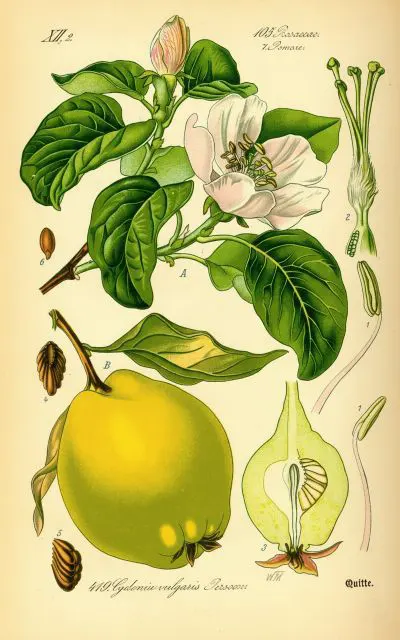Common Quince
Common Quince
Cydonia oblonga Mill.
Rosaceae Family
Description of Quince
Common quince is a small tree or shrub, 5–16 ft (1.5–5 m) tall, with grayish-brown bark and a dense crown. Leaves are alternate, oval, 2–4 in (5–10 cm) long, dark green above and grayish-pubescent below. Flowers are solitary, large, 1.6–2 in (4–5 cm) in diameter, white-pink, with five petals. Fruits are apple- or pear-shaped, 2–4 in (5–10 cm), yellow, aromatic, with hard flesh and numerous seeds (up to 50). Cultivars: ‘Vranja’, ‘Champion’, ‘Smyrna’. Flowering occurs in May–June, fruiting in September–October.
Distribution and Ecology of Quince
Quince originates from the Caucasus, Central Asia, and Iran. It grows wild in Turkey, Greece, Crimea, and the Caucasus, up to 4,600 ft (1,400 m) above sea level. It is cultivated in the Mediterranean, Central Asia, Southern Europe, and parts of North America and Australia. It prefers loamy soils (pH 6.0–7.0), temperatures of 68–77°F (20–25°C), and watering of 5–8 gal (20–30 L) per tree every 10–14 days. Propagation is by cuttings, grafting, or seeds. Yield: 66–110 lb (30–50 kg) per tree. Care includes pruning, phosphorus fertilization (0.7–1 oz/m² or 20–30 g/m²), and protection against codling moth and powdery mildew. Quince stabilizes soils and is used in landscaping.
Raw Materials from Quince
Raw materials include fruits (fructus Cydoniae), seeds (semen Cydoniae), and leaves (folia Cydoniae). Fruits are harvested in September–October and dried at 104–122°F (40–50°C), yielding 15–20%. Seeds are extracted from fruits and dried at 86–104°F (30–40°C), yielding 5–10%. Leaves are collected in June–July and dried at 104°F (40°C), yielding 20–25%. Quality standards: fruits yellow, mold-free; seeds brown; leaves green; moisture ≤12%. Store in airtight containers (fruits: 1 year; seeds: 2 years; leaves: 1 year). Fruits have a fragrant aroma and a tart, astringent taste.
Chemical Composition of Quince
Fruits contain sugars (up to 10%, glucose, fructose), organic acids (malic, citric, up to 2%), pectins (up to 3%), vitamins (C up to 30 mg/100 g, A, B1, B2, PP), flavonoids, tannins (up to 1%), and minerals (potassium, calcium, iron). Seeds contain mucilage (up to 20%), amygdalin, and fatty oil (up to 15%). Leaves contain flavonoids, tannins (up to 5%), and essential oil. Fruit calories: 40–50 kcal/100 g.
Uses and Benefits of Quince
Quince provides astringent, anti-inflammatory, diuretic, choleretic, enveloping, and antiseptic effects. It may support digestion, reduce inflammation, and promote general health. It is used in traditional remedies for diarrhea, gastritis, stomach ulcers, liver conditions, anemia, hypertension, bronchitis, and skin inflammation. Fruits aid digestion and strengthen the intestines. Seed mucilage is used for coughs, burns, and ulcers. Leaf infusions may help with hypertension and sore throats. Juice may support cholesterol reduction and vascular health. Consult a healthcare professional before medicinal use.
Precautions for Using Quince
Consuming more than 2.2 lb (1 kg) of fruit or 6.8 oz (200 ml) of juice daily may cause constipation or bloating. Seeds (>0.35 oz or 10 g/day) are toxic due to amygdalin, potentially causing nausea or dizziness. Store juice at 32–41°F (0–5°C) for no longer than 48 hours. Limit children under 3 to 1.8 oz (50 g) of fruit daily. Wash fruits thoroughly to remove pesticides. The fuzzy coating on fruits may irritate the throat; remove before consumption.
Contraindications for Using Quince
Quince is contraindicated for allergies to Rosaceae, chronic constipation, gastritis with high acidity, acute ulcers, pregnancy, and lactation.
Medicinal Recipes with Quince
- Seed decoction for cough. Boil 0.18 oz (5 g) seeds in 6.8 oz (200 ml) water for 10 minutes, drink 1.7 oz (50 ml) 3 times daily, 5 days.
- Leaf infusion for hypertension. Steep 0.35 oz (10 g) leaves in 6.8 oz (200 ml) boiling water for 20 minutes, drink 1.7 oz (50 ml) twice daily, 10 days.
- Juice for anemia. Drink 3.4 oz (100 ml) juice twice daily, 7 days.
- Poultice for burns. Soak 0.35 oz (10 g) seeds in 3.4 oz (100 ml) water for 1 hour, apply for 15 minutes twice daily, 5 days.
Cosmetic Uses of Quince
Quince is used in skincare and haircare.
- Moisturizing mask. Mix 0.7 oz (20 g) fruit pulp with 0.34 oz (10 ml) honey, apply for 15 minutes, rinse, twice weekly.
- Toner for oily skin. Mix 0.68 oz (20 ml) juice with 0.34 oz (10 ml) water, wipe skin once daily.
- Hair mask for strengthening. Mix 0.7 oz (20 g) pulp with 0.34 oz (10 ml) olive oil, apply to hair for 30 minutes, rinse, once weekly.
- Poultice for acne. Steep 0.35 oz (10 g) leaves in 3.4 oz (100 ml) boiling water for 20 minutes, apply for 10 minutes twice daily.
Culinary Uses of Quince
Quince fruits are used in jams, compotes, desserts, and sauces.
- Compote. Boil 7 oz (200 g) fruit in 34 oz (1 L) water with 1.8 oz (50 g) sugar for 15 minutes.
- Jam. Boil 2.2 lb (1 kg) fruit with 1.8 lb (800 g) sugar and 6.8 oz (200 ml) water for 40 minutes, store in sterilized jars.
- Puree. Boil 1.1 lb (500 g) fruit for 20 minutes, blend, serve with honey.
- Baked quince. Halve 2 fruits, remove seeds, bake with 0.7 oz (20 g) honey at 356°F (180°C) for 30 minutes.
Tips: Store fruits at 32–41°F (0–5°C) for up to 3 months, dried fruits for up to 1 year. Remove fuzz and seeds before preparation.
Other Uses of Quince
Quince is used in landscaping, as a honey plant, and for soil stabilization.




